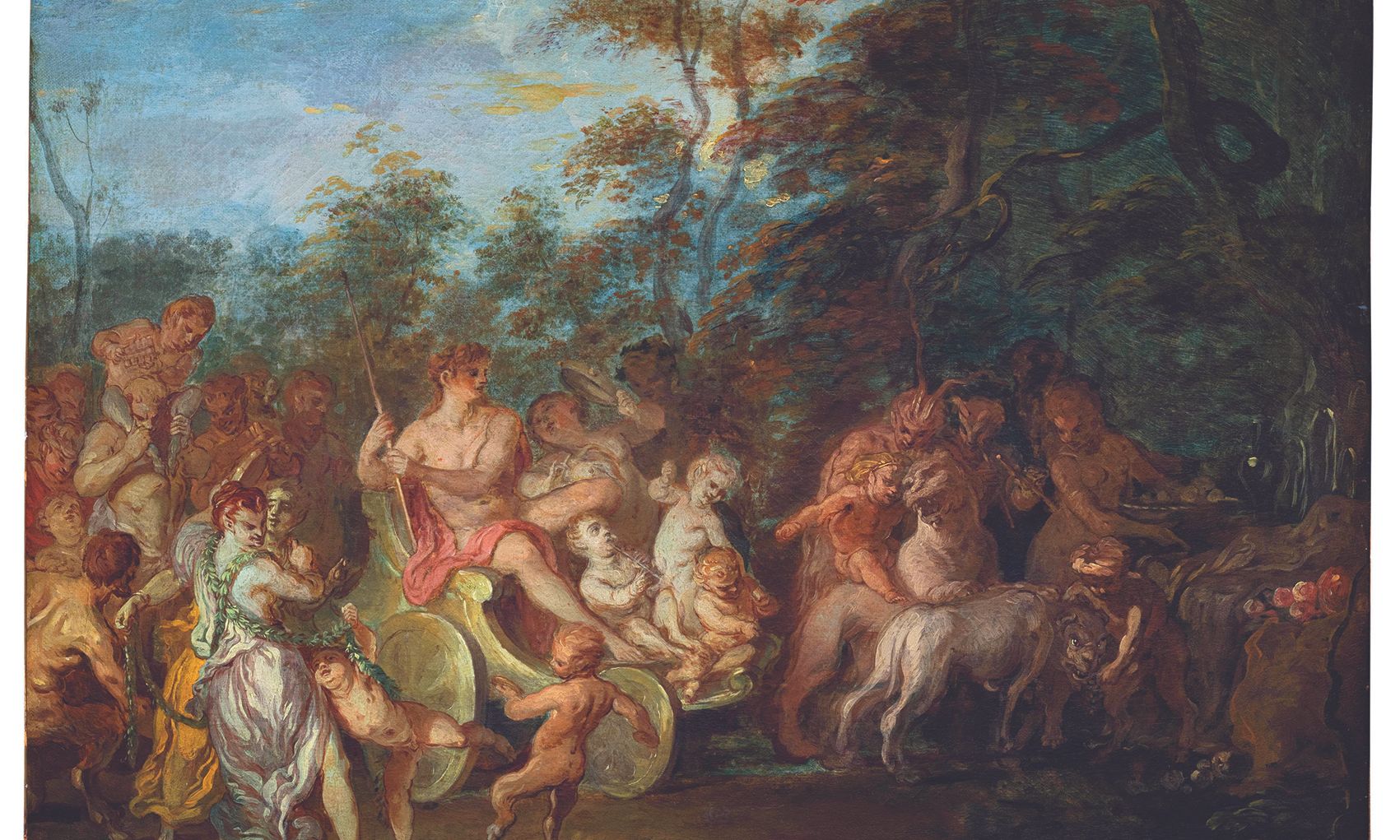A predilection for theatrical scenes: Claude Gillot’s Triumph of Bacchus (1700-10), detail © Morgan Library & Museum
If the name of Claude Gillot (1673-1722) is known at all outside specialist circles, it is as the teacher of a much more famous artist, Antoine Watteau. Even within the field of 18th-century French art history, Gillot’s reputation rests primarily on his role as the pioneer of genres that his celebrated pupil made his own. As the collector and amateur engraver Jean de Jullienne remarked of Watteau in 1726, the younger artist “had a taste for fêtes champêtres, theatre scenes and modern costumes, in imitation of his master”.
The only work by Gillot himself to be at all well-known today is a large canvas in the Louvre (Les Deux Carrosses, 1707) that is based on a theatre scene reportedly inspired by a real-life incident when two carriages met head-on in a narrow Parisian street. It is a staged scene set against a painted backdrop, with wheeled sedan chairs for carriages. The two ladies in the carriages disputing with each other for priority are played by characters from the Commedia dell’arte, Harlequin and Scaramouche, in drag. Its lively humour is typical of Gillot’s work.
Apart from this painting and a few others associated with Gillot’s name, his surviving work consists entirely of drawings and prints. This fact has contributed to his relative obscurity. So too has the very slender documentary record for his life and work. Until now, there has been no full-length study of Gillot in English, which makes Jennifer Tonkovich’s book very welcome. Produced to accompany an exhibition at the Morgan Library & Museum in New York (until 28 May), it stands on its own as a major work of scholarship.
Tonkovich, the Morgan’s curator of drawings and prints, has painstakingly pieced together the evidence to reconstruct Gillot’s career as far as possible. She challenges the received notion that he gave up painting after Watteau left his studio around 1709 because he recognised that he could not compete with his former pupil. In fact, Tonkovich points out, Gillot was accepted as a full member of Paris’s Royal Academy of Painting and Sculpture in 1715. He submitted a biblical scene as his reception piece, thereby gaining admission with the elevated status of history painter.
Nevertheless, as Tonkovich emphasises, Gillot’s career was centred outside the academy, in the commercial milieu of artists who catered to the growing demand for decoration and entertainment in Paris during the final decades of the long reign of Louis XIV (died 1715) and during the Regency that started the reign of Louis XV. Gillot seems to have lived in or near Rue Saint-Jacques, the historic printers’ quarter of Paris. The burgeoning demand for prints provides one context for his career. Another is the theatre, more particularly the troupe of Italian comedians who operated in the city’s fairgrounds between 1697 and 1716. Sadly, however, Tonkovich is inclined to doubt the longstanding identification
of the artist with a certain Gillot who wrote plays and ran a marionette
theatre at the Saint-Germain fair.
After an opening biographical chapter, the book is organised thematically around different aspects of Gillot’s work, which extends to designs for costumes and scenery for the opera, book illustration and interior decoration. The core of his work, however, consists of drawings of three distinct subjects: bacchanals and other scenes of pagan antiquity, theatrical scenes based on the repertoire of the Italian Commedia and the rural scenes that contemporaries called fêtes champêtres. They were all conceived serially, to be collected and preserved in groups. Many were engraved, though most of the prints after his compositions were only published after his death.
Tonkovich views Gillot as a distinctively modern figure, with a satirical bent that accords with a sceptical outlook typical of the Enlightenment. In significant respects, he seems rather to belong to a premodern world in which art was not yet set apart from everyday life. In 1715, for example, a Swedish visitor recorded having visited the workshops of two “artisans”: one was a carriage painter, the other was Gillot, who was then engaged in designing tapestries.
However, Gillot ended his career in a distressingly modern way: losing most of his money in the financial collapse of 1720.

